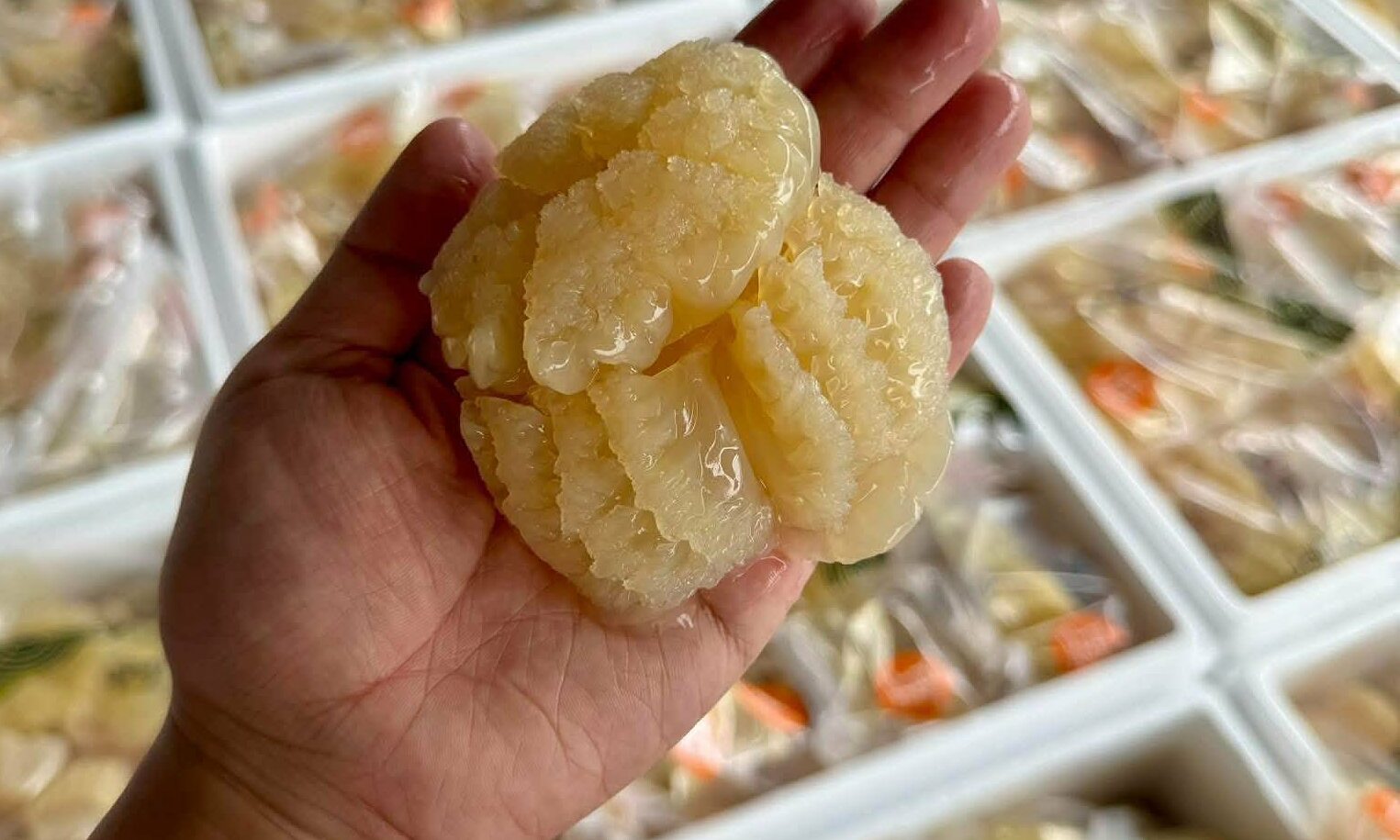The name "cannonball jellyfish" comes from its round shape with a bullet-like head and a denser, crispier texture than common jellyfish. Scientifically known as *Stomolophus meleagris*, it is commonly found in Thailand and East Asia and is now creating a buzz after being imported to Vietnam.
According to business circles, videos of people eating whole cannonball jellyfish on TikTok and Facebook have fueled strong demand. Mukbang, the trend of eating in front of a camera and broadcasting live, has transformed this once-unfamiliar seafood into a sought-after item.
"Customers mainly buy it to film videos or try a new flavor. This curiosity is what makes it sell so well," said Nguyen Thi Hoa, owner of an imported food store in Hoa Hung ward (TP HCM).
 |
Thai cannonball jellyfish imported to Vietnam by a shop in TP HCM. Photo: Thanh Hong |
Hoa shared that last week her store imported over 200 kg of Thai cannonball jellyfish, but it sold out in just a few days. The 5-7 jellyfish per kg variety is currently selling for 900,000 VND, while the variety with fewer jellyfish, pre-marinated, costs around 800,000 VND per box.
In Tan Thoi Hiep ward, Le Thu Hang, owner of a fresh and imported seafood store, also confirmed that this is the most popular product of the past month. According to Hang, despite the price being 8-9 times higher than domestic jellyfish, the Thai variety is still favored thanks to its eye-catching shape, thick, translucent body, and distinctly crunchy texture.
Not only in TP HCM, this trend has quickly spread to Hanoi and Da Nang. Some Vietnamese TikTokers in Japan have also joined in, leading to an increase in imports from Japan in addition to Thailand. Online, many vendors are offering pre-processed versions, mixed with mango or fish sauce, for 400,000-800,000 VND per box, further fueling the craze.
In Thailand, cannonball jellyfish is an important commercial seafood product. According to the Thai Department of Fisheries, the main source comes from seasonal harvests in the Gulf of Thailand and the Andaman Sea, so production fluctuates significantly.
In 2023, Thailand exported 7,150 tons of jellyfish, worth 16.34 million USD, with China, Japan, and South Korea as the main markets. FAO reports also noted that from 1988-1999, Southeast Asia harvested an average of 169,000 tons of fresh jellyfish annually, with Thailand being a significant supplier. However, because jellyfish contain up to 95% water, the processed weight is only a small fraction of the initial harvest.
In Vietnam, according to the Customs Department, in the first 8 months of this year, seafood imports from Thailand reached 12 million USD, a 20% decrease compared to the same period in 2024. The main imported items are jellyfish, salted seafood, dried squid, and some specialty fish.
According to management authorities, many shipments are brought in through hand-carried or unofficial channels, without quarantine, posing food safety risks. Therefore, consumers should buy from reputable sellers with documented origins to avoid wasting money. Management authorities will strengthen inspections and handle smuggling cases to protect buyers.
Previously, other specialties such as squid, Hue mussels, soursop tea, bamboo shoots, or Guangdong lemons also caused similar buying frenzies. Although the trends may subside, the prices of these specialties remain twice as high as before. However, many consumers who followed the mukbang trend reported stomach aches or said the seafood wasn't as delicious as advertised online.
Hong Chau












